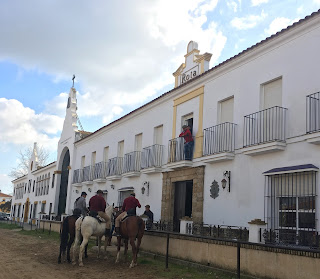THE ORIGINAL "Wild West" - IN SOUTHERN SPAIN
Note: all videos are very short - and they finally work!
You can enlarge any of the photos or videos.
You can enlarge any of the photos or videos.
Note Badger & Ratty and a bit of Tim on the right.
Of all the adventures we had on our 2016/17 two-month travels in Spain and Portugal (I've wanted to do this posting for more than a year), the most amazing one was a complete surprise. From our campsite at the village of El Rocío in southern Spain, on the edge of Parque Doñana, one of Europe's most important nature reserves, we walked into a village that looked like a Hollywood western movie set, explained in part by many of the original settlers in the southwestern U.S. and Mexico having come from this part of Spain.
None of the streets were paved - they were all sand (as were the roads in the campsite) and there were horses and carriages everywhere. As we walked along the main street with the dogs, we were astonished and thrilled. Ratty and Badger passed dozens of horses before finally becoming blasé.
It was the last weekend of January 2017 and this was a sort of rehearsal for the annual religious pilgrimage to the village of El Rocío (la Romería de El Rocío). The Romería itself takes place in late May or early June, on the Thursday before Whit Sunday (21st of May in 2018), attracts about a million people and is unlike any of the other religious festivals in Andalucía. (See the link at the bottom for photos and videos of the pilgrimage itself.)
The tradition of the Romería goes back centuries and is supported by about 120 brotherhoods (hermandades), the main one and organizer being the Hermandad de Almonte. Most of the brotherhoods are from southern Spain, but some are from as far away as Brussels. The oldest ones date back to the 17th century. Each has its own house, the size and style determined by the status and membership of the individual hermandad:
Bars along the main street cater to their customers on horseback - no need to dismount for a copa de vino.
The horses themselves were equipped with traditional saddles and stirrups unlike any we'd ever seen:
There was evident pride among many of the women and men on horseback - note this elegantly dressed woman sitting sidesaddle and the fellow below just begging to be photographed:
A woman riding sidesaddle, behind her partner:
Most people ignored us tourists, but a few invited us to come closer and to participate.
Impromptu flamenco at one of the brotherhood houses in El Rocío:
The focus of the pilgrimage is the Catedral or Ermita, where the statue of the Virgen del Rocío is kept and brought out on the main day of the Romería:
From a café table, we and the dogs watched the lively paseo of beautifully groomed horses and decorated, belled carriages carrying exuberant families and friends - and tried to imagine what it must be like during the Romería itself, with a million people in traditional dress, no cars and far more horses and carriages participating in the pilgrimage and partying at their hermandades.
More information here on the Romería itself, though there are lots of other online details and photos:
______________________________________________________________________________











No comments:
Post a Comment